Bright, herbaceous, and delicious, my recipe makes for a lovely Pesto Pasta with a homemade Pesto Sauce made from scratch. My recipe is also vegetarian and can be easily made into a plant based one. Made with just 6 simple ingredients, this tasty, fresh meal can be on the table in only 30 minutes.
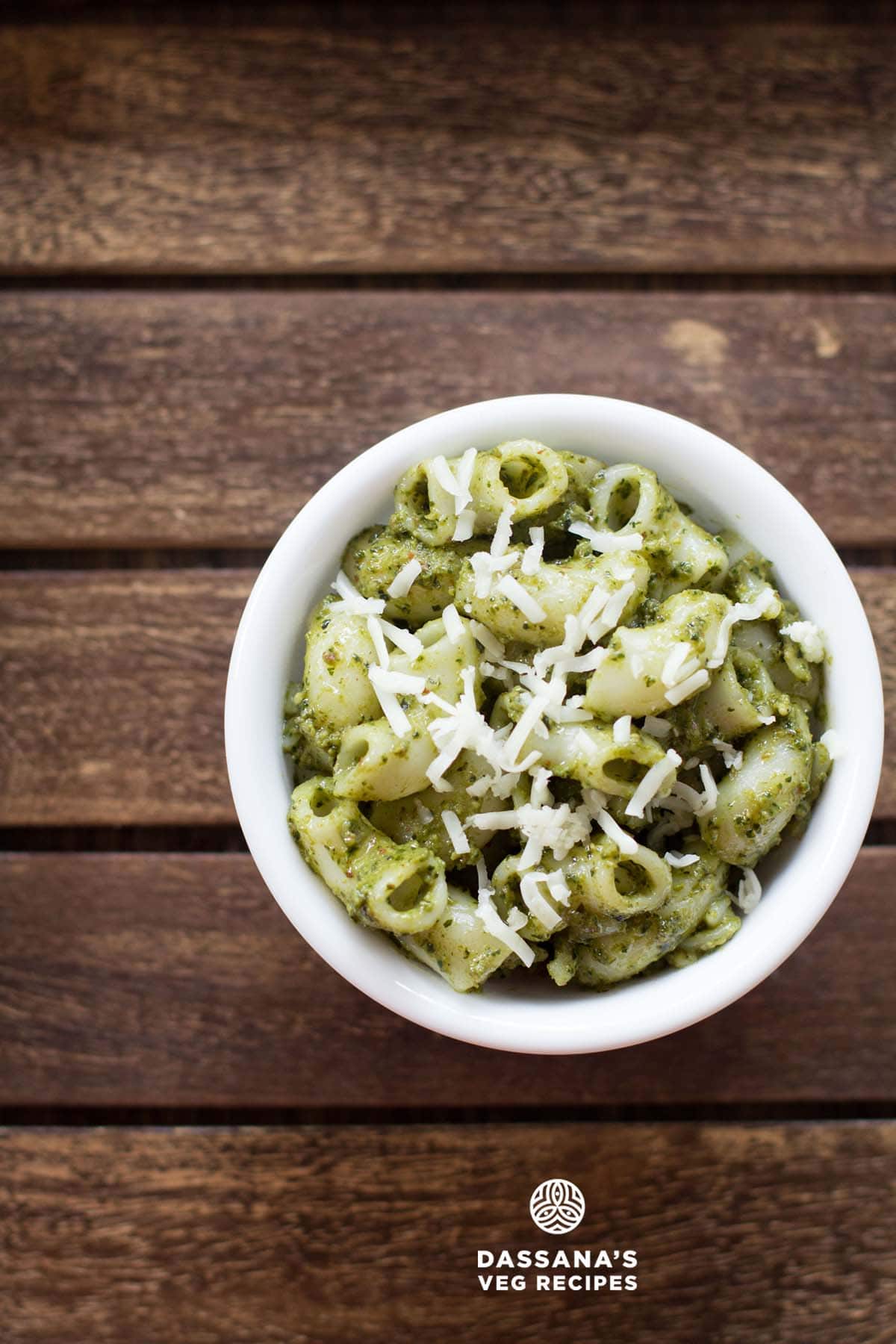
About Pesto Pasta
Pesto is one of my favorite green sauces and this simple, homemade version is delicious. I love making homemade pesto to use on pasta and pizza as it is so much more fresh and flavorful than store-bought sauce.
This vegetarian recipe includes fresh basil leaves, garlic, extra virgin olive oil, and almonds, leaving the vegetarian parmesan cheese as a garnish for the pasta.
The parmesan cheese I use is not the traditional parmesan a.k.a parmigiano reggiano that is made with animal rennet, thereby making this recipe vegetarian.
When you make this recipe, look out for parmesan cheese that is made with microbial rennet or plant based rennet.
Table of Contents
For a vegan version, simply skip dusting your finished pasta with cheese or opt to use a plant-based alternative.
Making pesto from scratch may seem like a lot of work, but it is actually quite simple. In fact, all you need are 6 easy-to-find ingredients and a food processor to whip up a batch. If you’re only making the pesto (not the pasta), you’ll be done in just 15 minutes!
This recipe will show you how to lightly toast the almonds to bring out maximum flavor before grinding them. It will also go over how to crush the basil leaves while adding *just* the right amount of oil for the perfect sauce consistency.
Ingredients & Substitutions
- Nuts: Typically pesto sauce is made with pine nuts, however in this recipe I have replaced them with less expensive almonds. You can also use cashews, pistachios, pecans, walnuts, macadamia nuts, or even sunflower seeds instead of pine nuts.
- Herbs or Leafy Greens: Fresh basil is the traditional ingredient that gives a lovely herby aroma and flavor to the sauce. That said, you can make lots of different kinds of pesto using soft herbs like cilantro or parsley, or even leafy greens like arugula or kale.
- Extra Virgin Olive Oil: True EVOO has a lovely vegetal quality that lends lots of flavor to pesto, I suggest you do not use any other oil. Use the best quality extra virgin olive oil you can.
- No Parmesan Cheese: Pesto usually has parmesan cheese mixed into the sauce, but I kept it separate for a garnish on the pasta instead. This makes it easy to transform the pesto pasta into a vegan dish, or to use the sauce in any of your favorite plant based recipes.
- Pasta: You can use any shape of pasta that you wish, long or short. I used a mix of fusilli pasta and macaroni pasta. For a healthier dish, use whole wheat pasta. You can also swap in gluten-free pasta if needed.
How To Make Pesto Pasta
Making pesto pasta is as easy as blending up a homemade pesto sauce, boiling pasta, and tossing them together. Here’s how it’s done:
Make Basil Almond Pesto
1. Heat a frying pan over low flame and place ¼ cup of almonds in it. Keep the heat on low.
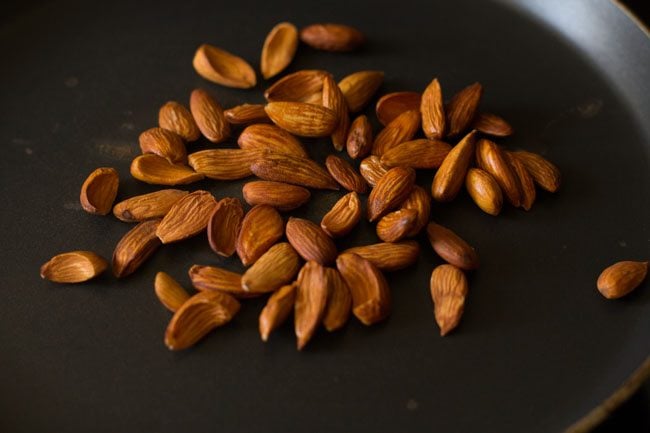
2. Lightly toast the almonds, stirring often for 2 to 3 minutes. Remove the lightly toasted almonds from the pan and let them cool to room temperature.
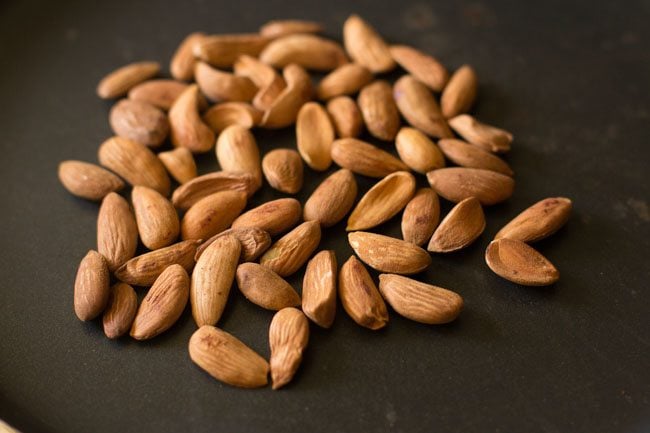
3. Then place the almonds in a food processor, food chopper, or a small to medium grinder jar. I have used a food chopper.
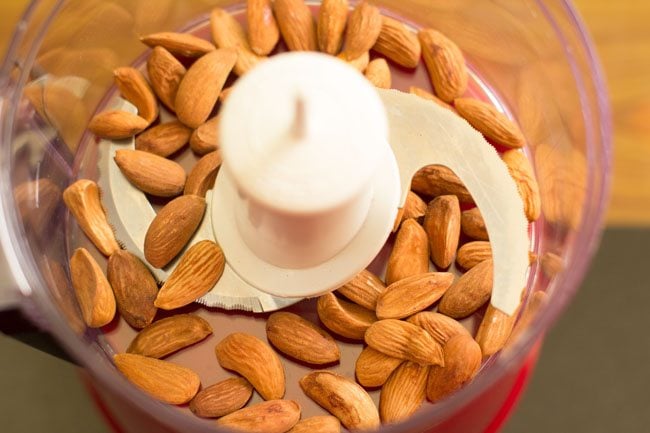
4. Process the almonds to a coarse texture.
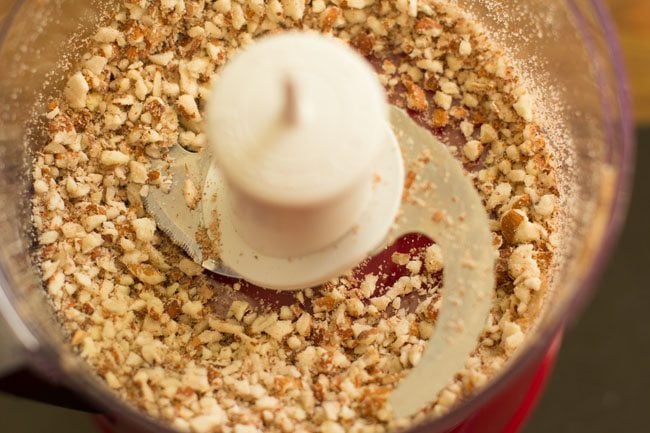
5. Rinse 2 cups (50 grams) of basil leaves and dry thoroughly. You can place leaves in a colander or strainer to dry naturally or you can use a salad spinner to dry them quicker.
Add the washed and dried basil leaves to the food chopper. Add 2 small to medium garlic cloves.
Optionally you can also add 4 to 5 whole black peppers. Sprinkle ⅛ teaspoon salt or add according to taste.
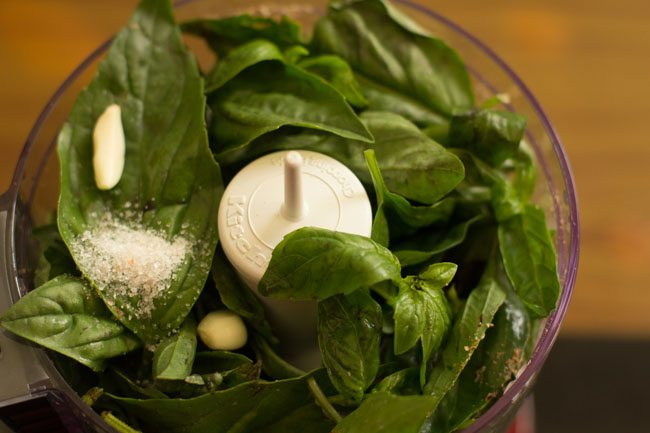
6. With the machine running, pour olive oil in 3 to 4 batches from the top vent of the food chopper or food processor lid. Add a total of ⅓ cup extra virgin olive oil.
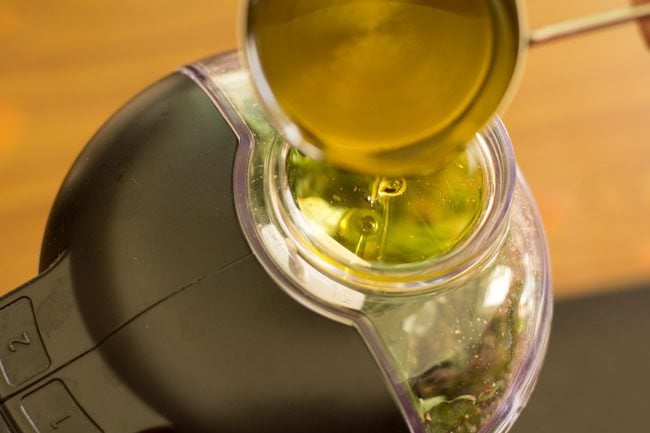
7. Blend to a semi-fine or fine consistency. You can blend it into either a smooth or slightly chunky sauce according to your preferences. You can also add a few drops of lemon juice to help preserve the green color.
Use a spatula to remove the pesto from the sides and bottom of the food processor, food chopper, or grinder jar. Place it in a mixing bowl or storage container. Cover and set aside.
Make-Ahead Tip: Your pesto is now ready for eating or storing! If you decide to hang on to it for later, place in a small, airtight container, level out the top and cover it with a thin coating of oil to prevent oxidation. The pesto will last in the fridge for up to a week or in the freezer for up to 2 months.
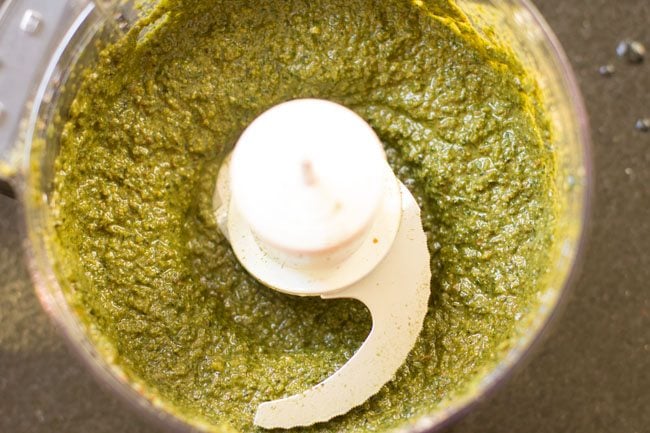
Make Pesto Pasta
8. Bring 5 to 6 cups water to a boil on a medium to high heat. Add 1 teaspoon salt to the water.
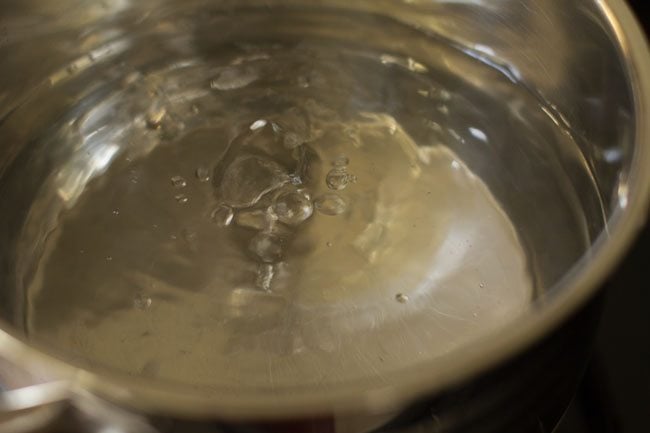
9. When the water comes to a boil, then add 2 cups fusilli or macaroni pasta (200 grams). You could also use spaghetti or your favorite pasta.
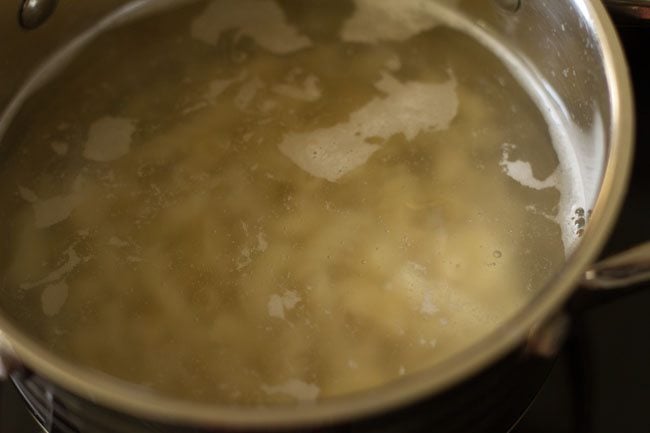
10. Cook the pasta according to package directions or until they al dente or softened. You could cook them al dente if you prefer.
With a slotted spoon, remove the pasta from the pan. Drain the water very well.
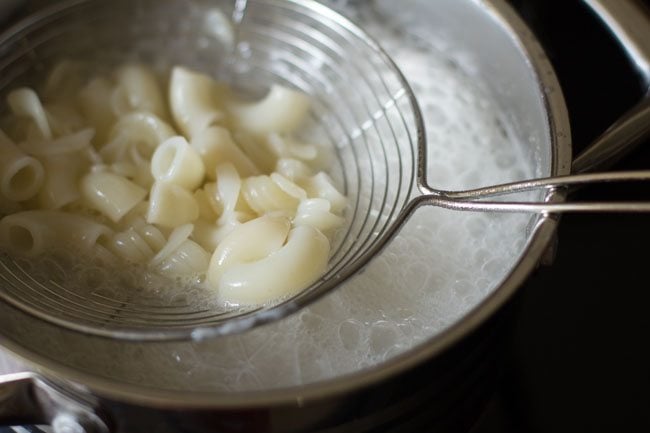
11. Add the cooked pasta in a mixing bowl.
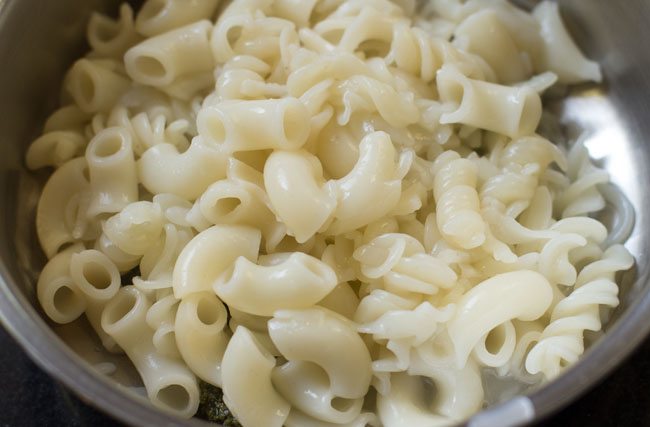
12. Add all of the prepared pesto sauce and mix very well. If you want you can add some lemon juice, crushed black pepper, or extra virgin olive oil at this point.
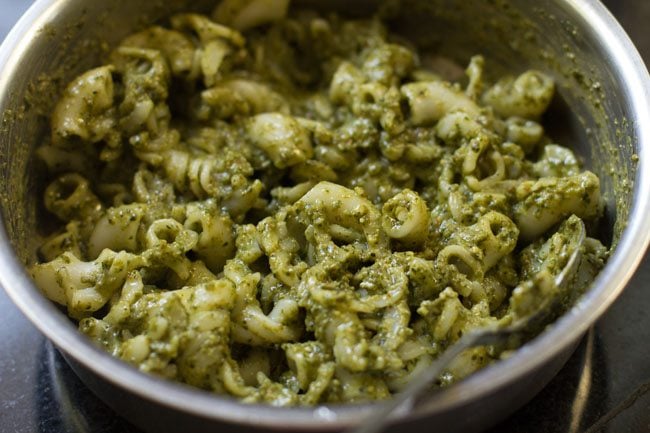
14. Serve pesto pasta garnished with some vegetarian parmesan cheese. You can also garnish with cheddar cheese or vegan cheese. Garnish is optional.
Pesto pasta can be served warm, at room temperature, or even chilled like a pasta salad.
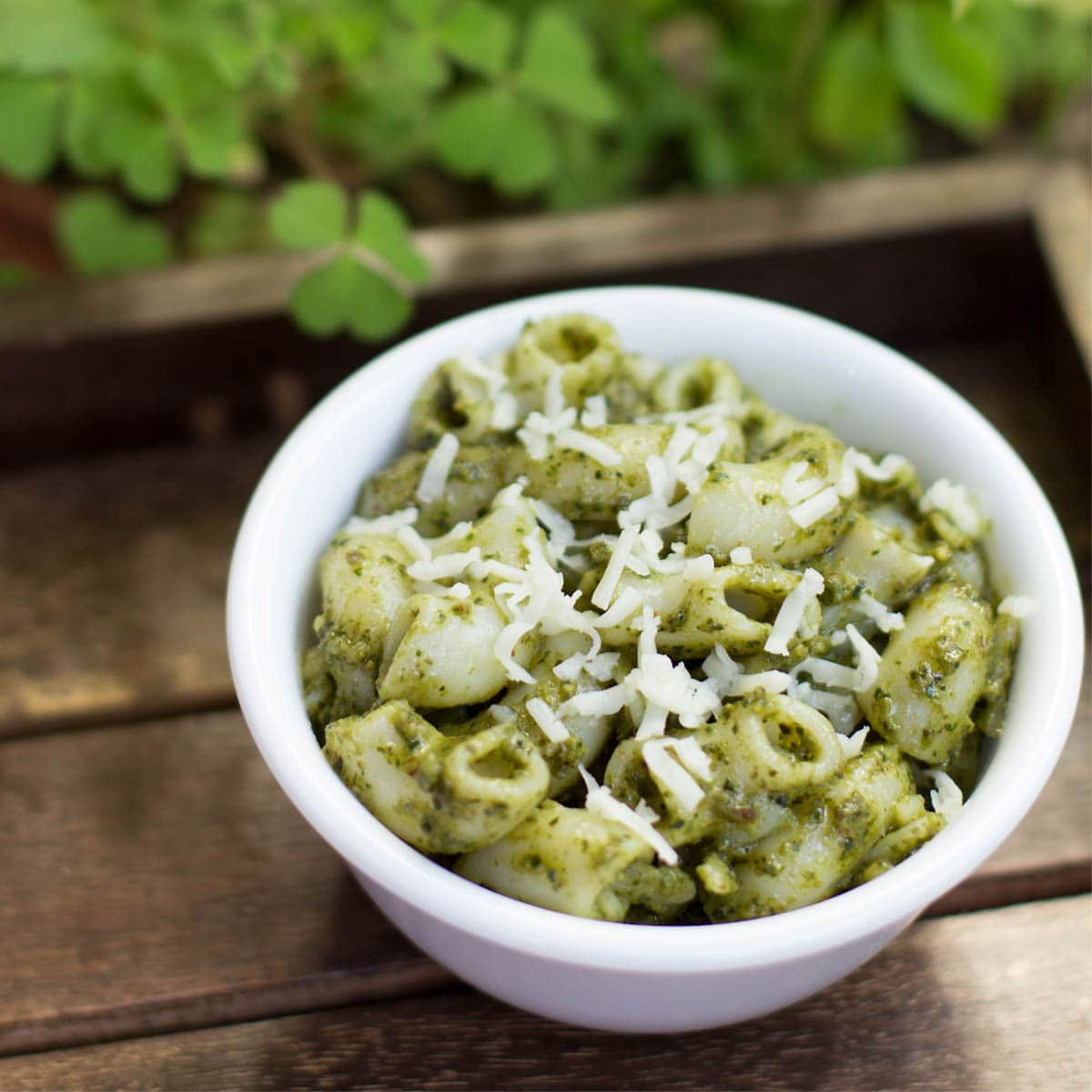
Variations
My mostly traditional basil pesto is a vegetarian delight, whether you turn it into pesto pasta or not. That said, there are a few ways you can customize this dish to your liking. Here are some of my favorite variations:
- Plant based. The pesto sauce itself is entirely vegan, so when it comes time to making the pesto pasta, simply omit adding the parmesan. You can also opt to swap in a vegan substitute like nutritional yeast for some “cheesy” flavor, or use a plant-based cheese alternative.
- Spicy. Feel free to add some crushed red pepper flakes, whole black peppercorns, or even a diced green chile to the mix, per your preference.
- Different Nuts. Pine nuts (a.k.a. pignolias) are traditional in Italian pesto, but I opted to use almonds because they are less expensive and easy to find. You can also opt to use pretty much any other nut including pistachios, cashews, walnuts, pecans, or macadamia nuts.
- Different Greens. Basil pesto is the most well-known, but you can also make pesto out of any tender green like cilantro, parsley, chives, spring garlic, arugula, or baby kale.
- Nut-Free. Can’t eat nuts? No problem! Substitute sunflower seeds or pepitas (a.k.a. pumpkin seeds) instead!
Expert Tips
- Fresh Is Best: Use fresh basil (or any type of green you choose) in the recipe. Avoid dry or wilted leaves.
- Scale Up As Needed: This pesto recipe is for 2 cup of dried pasta, but you can easily double or triple the sauce recipe to have it for a larger serving of pasta or pizzas, or just to have in the fridge for when you need to add some extra flavor to your sandwich or toast.
- Add Vegetables: If you are looking for added nutrition or a heartier dish, feel free to add some mixed veggies to the pasta and sauce. Simply steam, boil, roast, or otherwise cook some vegetables and toss them with the finished pasta and sauce.
- Basil: Ensure that the basil leaves are fresh and green. Do not use wilted or dried basil so as to get the maximum aroma and flavor in the pesto.
- Almonds: I have toasted/roasted the almonds in a pan, you could easily toast them in an oven. Additionally make sure to use almonds that in their shelf life and have not become rancid or taste bitter.
FAQs
That all depends on your preferences! It’s great eaten as a hot dish, but can also be served chilled like a pasta salad. If you’re going the cold route, consider adding in halved cherry tomatoes, small pieces of fresh mozzarella, and a quick basil chiffonade for more freshness.
The uses are nearly endless! Add a dollop to your hummus, mix some into your mayonnaise before swiping on a roasted veggie sandwich, use it as a dipping sauce for your grilled cheese or crudités, add a dollop to a bowl of Tomato Soup, thin it out with olive oil for dipping bread into, use it as a sauce on your pizzas… seriously. There’s almost nothing this tasty, herby sauce can’t do!
About 5 to 7 days in the fridge if kept in an airtight container with a small layer of oil or water on top to prevent oxidation, or up to 3 months in the freezer.
Pro Tip: Freeze the pesto into ice cubes so you can pull out just a tablespoon or two at a time as you need it!
More Delicious Pastas To Try!
Pasta Recipes
Pasta Recipes
Pasta Recipes
Pasta Recipes
Please be sure to rate the recipe in the recipe card or leave a comment below if you have made it. For more vegetarian inspirations, Sign Up for my emails or follow me on Instagram, Youtube, Facebook, Pinterest or Twitter.
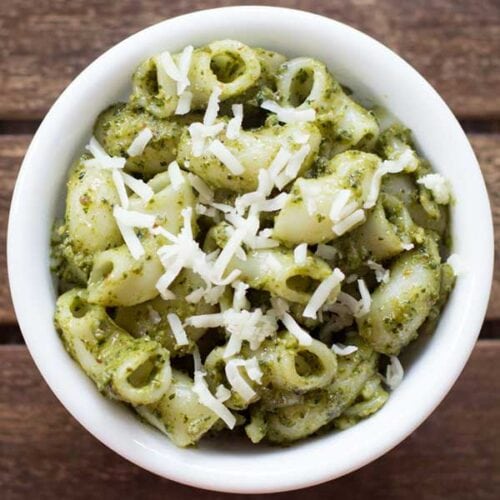
Basil Pesto Pasta (Vegetarian)
Ingredients
For the basil almond pesto
- 2 cups/50 grams basil leaves – fresh
- ¼ cup almonds
- ⅓ cup extra virgin olive oil
- 2 garlic cloves – small to medium-sized
- 4 to 5 black peppercorns – optional
- ⅛ teaspoon salt or add as required
For cooking pasta
- 2 cups/200 grams fusilli pasta or macaroni, you can also use 200 grams of pasta like spaghetti or farfalle or rigatoni
- 5 to 6 cups water or add as required
- 1 teaspoon salt or add as required
For Garnish
- 1 to 2 tablespoons vegetarian parmesan cheese – grated, optional
- 3 to 4 pinches crushed black pepper – optional
Instructions
Preparation
- Heat a pan and add lightly toast almonds for 2 to 3 minutes on a low heat. Set aside in a tray or plate for the almonds to cool.
- Rinse the basil leaves using a strainer or colander.
- Spread them on a tray or a dry colander or strainer so that they dry naturally. You can use a salad spinner to dry the leaves.
Making basil almond pesto
- Once the almonds cool at room temperature, add them in a food processor or food chopper or a small to medium grinder jar.
- Process and crush them coarsely.
- Add the basil leaves which has been rinsed first and then dried naturally. Also add the garlic cloves. Optionally you can also whole black peppers. Season with salt.
- Process or crush the leaves and from the top on pour olive oil in portions from the vent on the lid of the food processor or food chopper. If your food processor or food chopper, does not have a vent on the lid, then pour extra virgin olive oil directly into the jar in 3 to 4 batches. Close and seal the lid and blend/process after you add a batch of oil each time.
- Grind to a semi fine or chunky consistency according to your preferences. You can also add a few drops of lemon juice to preserve the green color.
- Remove the pesto in a mixing bowl or pan. Use a spatula to remove the pesto from the sides and bottom of the food processor, food chopper or grinder jar. Cover and set aside.
Making pesto pasta
- Bring water and salt to a boil on a medium to high heat.
- When the water comes to a boil, then add the pasta.
- Cook the pasta till they are al dente. Depending on your taste preferences, you can even cook them till they are softened.
- With a slotted spoon take the pasta from the pan. Drain the water very well.
- Add the cooked pasta in a mixing bowl. Add all of the prepared pesto sauce.
- Mix very well. If you want you can add some lemon juice or crushed black pepper or a drizzle of extra virgin olive oil.
- Serve Pesto Pasta garnished with some vegetarian parmesan cheese or vegan cheese. The garnish is optional.
Notes
Nutrition Info (Approximate Values)
This Pesto Pasta recipe from the archives was first published in December 2016. It has been republished and updated on November 2024.
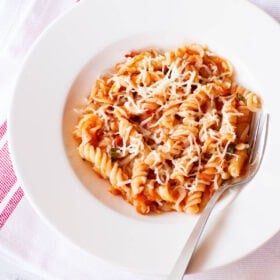
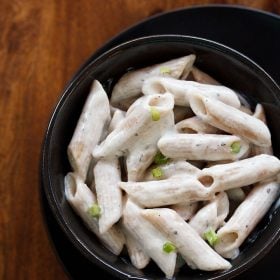
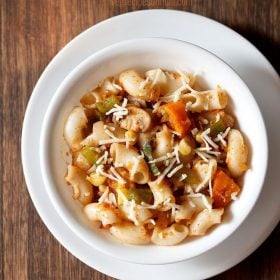
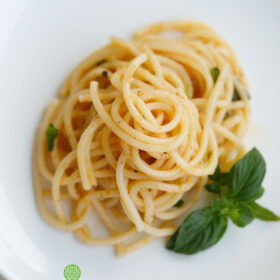
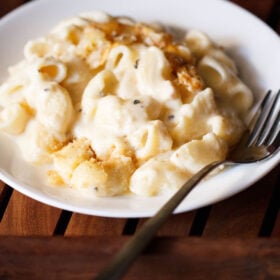
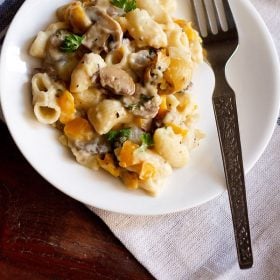
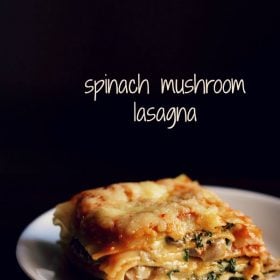
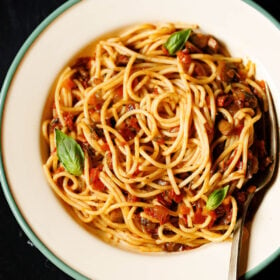








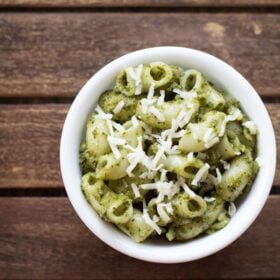
Such a simple and easy recipe! The pesto turned out so well!!
I am big follower or your recipe. Can Tulsi be used – as what I know is basil and tulsi are different.
Thanks. Do not add tulsi in the recipe. Both tulsi and basil are different.
Tried this recipe…it tasted yumm.. very simple and steps..thank you for sharing awesome recipes.
That is great to know and thanks for sharing the feedback. Welcome.
Tried this recipe today. Tastes yummy. My 12 year old loved it. Definitely healthier than the red sauce or white sauce recipe. Thanks a lot!
thanks hema. red sauce when made with fresh tomatoes, fresh herbs and olive oil is healthy. white sauce, when made with wheat flour, is a better version than one made with all-purpose flour.
awesome recipe, Ma’am!
used homegrown basil leaves to make it…turned out very well!
thanks radhika for the rating as well as the feedback on pesto pasta. even i had used homegrown basil leaves.
I just can’t thank you enough for your wonderful blog with amazing recipes…the amount of hard work u put in developing and sharing the recipe with us is so visible in all your recipes…although I have been following your blog for quite a while, felt guilty of not thanking you …and needless to say, this recipe turned out awesome..God bless…
Welcome Meena. Thanks a lot for your appreciation and kind words. Glad to know that you are liking the recipes shared on blog.
Just one thing: “al dente” does not mean completely cooked. It will not be fully soft, the proper al dente pasta has a little bit of firmness left in it. A bit of “bite”! That’s the authentic way of cooking it–not til it is totally soft. 🙂
Nice idea to use almonds.
i know. i should have used the word ‘and’ instead of ‘or’. i meant that depending on personal taste preferences, the pasta can be cooked al dente or till they are completely cooked. will change the line so that there is no confusion. thanks.
your recipes are just awesome.. i tired some of them.. the way you describe recipes with pictures.. just awesome.. i love it..
thanks a lot oyindrila.